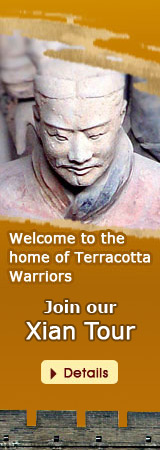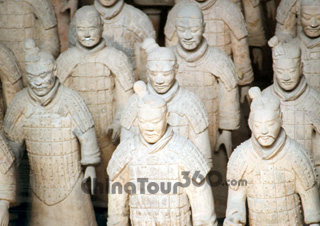 Xian Terracotta Army
Xian Terracotta Army A Warrior and Horses
A Warrior and Horses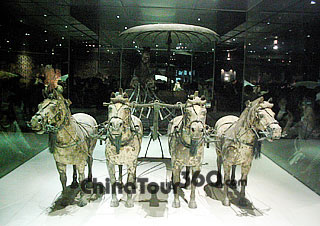 Bronze Chariots and Horses
Bronze Chariots and Horses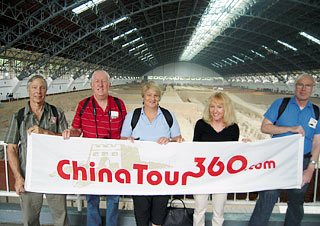 Terracotta Army Museum Tour
Terracotta Army Museum Tour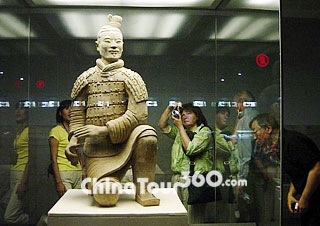 A Kneeling Archer
A Kneeling Archer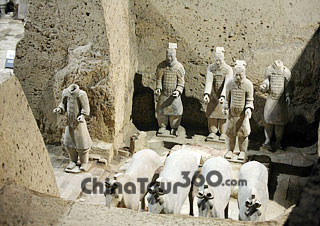 Pit 3, Terracotta Army
Pit 3, Terracotta Army
The Terracotta Warriors, also known as Terracotta Warriors and Horses Museum, is located about 36 kilometers (22.4 miles) east of Xian. It is known to many as the Eighth Wonder of the World and features life-sized sculptures of warriors and horses all with different facial expressions and postures. It is affiliated to the Mausoleum of Qin Shi Huang, the first emperor of the Qin Dynasty (221 BC - 206 BC) and the first unifier of China. The underground corps guards the mausoleum for over 2,000 years and displays the powerful army of the Qin Dynasty.
The clay warriors and horses were discovered accidentally when some local farmers sank a well at the foot of Mt Lishan in 1974. Excavation was later carried on the site and unearthed were more than 7,000 clay soldiers, over 100 chariots, more than 400 clay horses and over 100,000 pieces of weaponry. In 1980, another major dig revealed two sets of big painted bronze chariots and four horses - the most delicate, the largest and oldest bronzes of its kind in China. The Terracotta Warriors was listed as a World Cultural Heritage site in 1987.
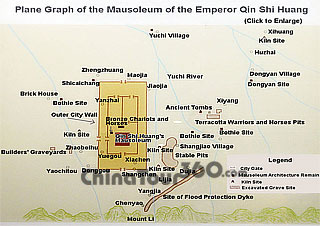 |
| Terracotta Warriors Map |
The museum mainly consists of three pits marked numerically in order of their excavation. It was supported by massive timbers and was covered with reed mats and earth. The clay figures are mostly 1.75 - 1.85 meters (5.74 - 6.07 feet) tall and represent all levels of an army-officers, armed warriors and ordinary soldiers. They are arrayed in battle formation, looking like imperial guards protecting a subterranean palace. When the original clay sculptures were first unearthed they were painted different colors, but because of their exposure to the atmosphere, they have gradually faded over time.
The Terracotta Warriors are the most significant archeological discovery of the 20th century in China. They are acclaimed to be on the same level of historical importance as the pyramids of Egypt and the sculptures of ancient Greece. The museum is a major world tourist destination, with about twenty percent of its visitors coming from outside of China.
![]() Pit 1
Pit 1
Pit 1 is the first site discovered and the largest one of the three pits. This rectangular pit covers an area of 14,260 square meters (3.5 acres), measuring 230 meters (251.5 yards) long, 62 meters (67.8 yards) wide and about 5 meters (16.4 feet) deep. The pit features infantry regiments and chariots. It has five inclining approaches in the east and west end, and is partitioned by ten compacted-earth walls.
In the front of the pit stand three rows terracotta warriors, seventy warriors being lined up in a row. They are supposed to be the vanguard of the whole infantry. Each row has a commander dressed in armor and the rest wear short suits, with their legs in puttees, which seems they are ready to start on a mission. Behind the three rows is the main body of the troop. 6000 warriors in armors and 35 chariots are lined up in eleven passages. 38 columns of the infantry are in neat lineup, and in each column there are horses and chariots.
![]() Pit 2
Pit 2
Pit 2 contains more than one thousand warriors which are the backbone of the whole underground army. It features a mixed force consisting of infantries, cavalries and chariots. The arrangement of the troop is permeated with great pomp. The pit is in the form of the letter L and has an area of 6,000 square meters (1.5 acres). The pit is now still under excavation and it is estimated that the pit has over 1,300 pieces of warriors and horses, more than 80 chariots, and tens of thousands of weapons.
In the exhibition hall, some warriors and horses unearthed are displayed in glass cases, which grants its visitors a close insight. These figures are very life-like and represent different kinds of warrior. Exhibited is the cavalryman with his saddled war-horse, officer, general, kneeling archer, standing archer and others, and each has its own story.
![]() Pit 3
Pit 3
Pit 3 is considered to be the command post of the underground terrace cotta army. It is the smallest pit of the three pits and the layout accords with the Chinese character '凹'. It measures 17.6 meters (19.2 yards) wide and 21.4 meters (23.4 yards) long. In the east there is a leaning long gateway and in the west lie three chambers, central chamber, northern chamber and southern chamber. In the central chamber, four horses, remains of a chariot and four warriors could be seen.
Excavated from the pit is one chariot remains, 4 horses and 68 warriors, and the arrangement of warriors are different from those of Pit 1 and Pit 2. The warriors in the other two are disposed in battle formation while the warriors here are lining the corridor. In the north chamber, there are the remains of deer's horn, the door and broken warriors.
![]() Cultural Relics Exhibition Hall
Cultural Relics Exhibition Hall
The exhibition hall is located in the northeast corner of the museum. Some precious cultural relics unearthed from the pits are displayed in the hall. There are ancient swords, different kinds of bronze weapons and other articles, among which two sets of bronze chariot and horses are the most valuable. The two sets of bronze chariot and horses are the most delicate bronze ware unearthed in China and are the biggest bronze in the world.
They were discovered 20 meters (21.9 yards) west to the Mausoleum of Qin Shi Huang in 1980. They were found broken into pieces in a collapsed coffin, but attain their original glamour after the restoration. The two chariots are named Bronze Chariot and Horses No. 1 and Bronze Chariot and Horses No. 2 by their excavation order. The Chariot No. 1 is placed ahead to safeguard the Chariot No. 2, and each chariot is drawn by four horses, with a single shaft. The Chariot No. 1 is equipped with bows, crossbows, arrow heads and shields, and its diver wears an officer's cap. The Chariot No. 2 has separate front room and back room, and is fitted out with over 1500 pieces of ornaments made of golden, silver and other material.
![]() Entrance Fee: (including Terracotta Warriors and Emperor Qinshihuang's Mausoleum Site Park)
Entrance Fee: (including Terracotta Warriors and Emperor Qinshihuang's Mausoleum Site Park)
CNY120 (Dec.1 to the end of Feb.)
CNY150 (Mar. 1 to the end of Nov.)
![]() Opening Hours:
Opening Hours:
Mar. 16 - Nov. 15: 08:30 - 17:00 (ticket Purchasing hours, and the last check-in time is 18:35)
Nov. 16 - Mar. 16 of the next year: 08:30 - 16:30 (ticket purchasing hours, and the last check-in time is 18:05)
![]() Transportation:
Transportation:
A. Take Tourism Bus No. 5 (306) Bus No. 914 or 915 at the East Square of Xian Railway Station and get off at Terracotta Warriors (Bin Ma Yong) stop;
B. Take Bus No. 307 at South Gate of the Tang Paradise, Big Wild Goose Pagoda or Banpo stop and get off at Terracotta Warriors stop;
C. There are free buses travelling between Terracotta Warriors and the Emperor Qinshihuang's Mausoleum Site; visitors can take the bus at the parking lots outside of Terracotta Museum or the Qinshihuang's Mausoleum.
![]() Q & A: Any of your questions about Terracotta Warriors will be answered.
Q & A: Any of your questions about Terracotta Warriors will be answered.



